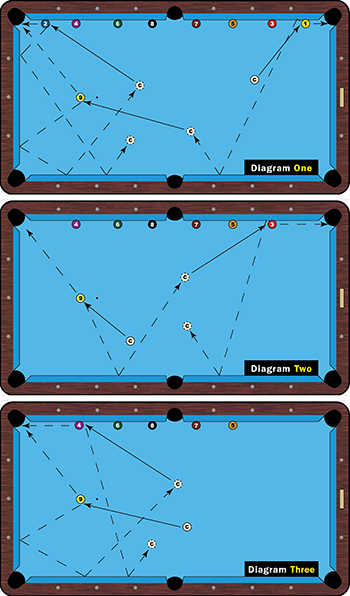This is another drill that will help you play the last two balls.
Iíve already shown you two ďmoney ballĒ drills, in which every shot must be treated like the last shot leading to the game-winning 9 ball. I love these drills because the natural tendency of players, particularly amateurs, is to get tense and tighten up on the penultimate ball. That invariably leads to mistakes. Late in the rack, players sense that they are just one ball away from that money ball and the tension starts to affect their stroke.
Iíve made a practice of doing these money ball drills during my comeback attempt because I want to feel the heat and get used to these shots to get perfect shape on the money ball ó the 9 ball.
Well, hereís another one!
Again, you must pocket the balls in rotation but after each lowest ball you pocket, the 9 ball must be pocketed next. You then re-spot the 9 and continue to the next lowest numbered ball. Youíre not allowed to bump another ball. Start with cue ball in hand.
Like the other drills, the object balls in this drill make you go from one end or side of the table for position on the 9 and then to the other side of the table for the next object ball. In this case, the balls are along one long rail and all balls are frozen to the rail.
As always, these drills require intense focus throughout, and you need to always be thinking three shots ahead.
Hereís how I would start out. This will give you an idea of how to approach the drill.
Start with the cue ball as shown (Diagram One) and use bottom left on the 1 ball and leave a decent angle on the 9. This is a nice feel shot to start off.
I like using a punch, run-through on a shot like the 9, striking the cue ball just above center. This kind of shot takes some practice. You could also play this with follow and left.
Now you have to play the 2 as the last ball before the money ball 9. Again, bottom left on this shot. Ideally, decelerate like a quit shot, which creates more spin. This is a shot Efren was a master at.
Use draw on the 9 ball with a half tip of left English (Diagram Two). This is a shot on which you can let your stroke out and get back to the center of the table. That will put you in control of whatís ahead.

If youíve reached the 3 ball you may start to tighten up a bit. Itís easy to get tense and choke a bit with these shots. Just stay down on the shot and donít hit it too hard. Use a half tip of left English here and just below center cue ball.
This shot will leave you a pretty healthy cut on the 9 ball (Diagram Three), but again you need to get the cue ball back to the middle of the table. Use follow with a good tip of left English. This shot is all about cue ball speed.
This brings us to the 4 ball. Use center cue ball on this shot with less than a half tip of right. This is the way I like to play this shot. Itís natural for me and helps the ball when itís near the rail. Relax and make sure youíre not tense here. Feel the shot, maintain a smooth stroke and make sure you stay down on the shot.
For the rest of the balls, focus on keeping a free stroke and knowing where your cue ball is going. Maintaining the proper angles is critical. If you leave too much or not enough angle on the shots, you wind up chasing the cue ball around the table. You also have to be careful with the side pocket opposite the rail where the balls are. You donít want to get careless and scratch.
And when you get to that final 9 ball, make sure you give 100 percent focus. This shot can be missed, especially when the heat is on.
Doing these drills will definitely benefit amateur and league players because this is the part of the game where you struggle the most. Get used to the heat and you will gain confidence going forward. Like all of the drills I share, this will also help you learn more about patterns, cue ball control and playing the right shots. And, trust me, these are shots that come up in every game.
But be warned: This drill is tough. Donít be discouraged. Even if you donít complete the drill, keep trying and always strive to beat your previous score. In doing so, youíll quickly see the benefits and the improvement in your pattern play and thought process.





